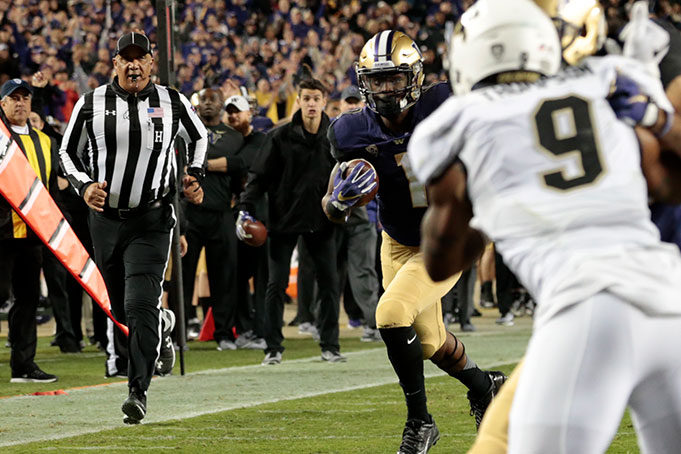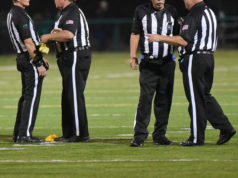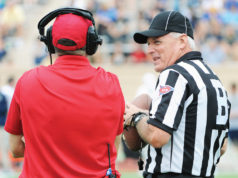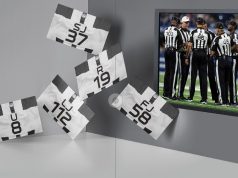The desire to rubberneck, gawk, stare and gape is often an involuntary behavior. Humans are innately curious and are often attracted to the most interesting and compelling surrounding objects and events. Many of us are easily distracted and we instinctively turn and look for the source of a car horn, siren or angry voice.
Football officials do not enjoy that luxury. Rubbernecking or ball-hawking is a difficult habit to break. However, visual discipline is essential for appropriate play coverage.
Officiating is a team sport. One of the first lessons new officials learn is to trust partners to make correct decisions in their respective coverage areas. In many cases, only one set of eyes will be on the player in possession of the ball. Consequently, crews should very rarely have multiple whistles when the ball is dead by rule. More than two whistles may indicate someone is ball-watching instead of observing his assigned off-ball area.
The following examples will not be a comprehensive mechanics manual review. Instead, they will identify occasions when rubbernecking is most likely.
Free kick.
It’s tempting to watch the ball in flight until the receiver catches the ball, then turn to focus on kick coverage and blockers. Sideline officials will self-identify as rubberneckers when they wind the clock after the ball is touched by the receiving team in the middle of the field. Pregame conversations should include the specific kicking team players each official will track after the ball is kicked and the subsequent coverage areas as officials transition from watching individual players to specific zones. Officials should not watch the ball in flight but sense its location based on player reactions and peripheral vision. Deep sideline officials should quickly shift attention to the ball from kicking team players and blockers only if their pylon is threatened.
Running play away.
The wing official on the side opposite of where the ball is going does not have relevant point-of-attack responsibilities. But his eyes may still be drawn to the ball because he dismisses the players behind the runner as immaterial. While the ball is live, the opposite wing must adopt a dead-ball officiating mindset by scanning the players behind the point of attack for unnecessary activity.
Passing play.
It is a difficult mental transition for new referees to stay with the quarterback after he releases the ball downfield. The excitement is no longer in the backfield and the temptation is to look downfield to witness the result of the throw. Referees must trust their crewmates to correctly observe assigned areas and make appropriate rulings. The crowd noise and the behavior of the players in his line of sight may be the referee’s only indication of the success or failure of the pass.
It’s also tempting for wing officials to stare into the backfield. They can glance quickly back toward the line of scrimmage after a few seconds to determine the quarterback’s status, but it’s imprudent to focus on the quarterback and lose sight of assigned receivers.
Runner in the open field.
When a runner breaks free from pursuers, all eyes are understandably focused on the ensuing footrace to the goalline. In that case, only the deepest official should have eyes on the ball. Unless the sideline or pylon is threatened, all other officials should be looking behind the runner at trailing players. That is a perfect example of dead-ball officiating principles applied while the ball is live, or what old-timers liked to call cleaning up behind the play. The trailing officials (referee following a long pass or run and back judge following an interception or punt return) should not progress beyond any players who lag behind.
Field goal or try.
Even a slight glance at the ball is inappropriate for officials not stationed under the uprights. The ball is clearly the most compelling object for most people in the stadium, especially on a long field goal attempt, but most officials will not witness the kick in flight. The referee is watching the holder and kicker, the umpire is watching the snapper and interior linemen and the officials not under the goalpost are observing blocks and the aftermath of the contact at the line. One important pregame discussion for a crew of five is to determine who is observing the block on the end of the line on the side vacated by the wing positioned under the upright.
Punt.
Sideline officials may be tempted to watch the receiver catch the ball. Only the covering official, typically the back judge, should witness the catch. The sideline officials’ focus should include blocks on kicking team players followed by coverage around and in front of the kick receiver. As with the free kick, there is no need to focus on uncontested players in space. However, officials can foresee potential problems by observing approach angles and the physical relationship between blockers and would-be tacklers. Unlike the field goal or try, sideline officials can momentarily locate the ball in flight to help predict pending action.
Forward progress spot.
When the ball is dead by rule, the official marking the forward progress spot must not approach the spot with head down and eyes on the ground. The ground has never caused a personal foul. The covering official should not immediately look at the referee to signal the down, look at the chains, or turn to the ball helper to receive a clean ball. The covering official should keep his focus on players until they separate and then attend to subsequent actions.
What's Your Call? Leave a Comment:
Note: This article is archival in nature. Rules, interpretations, mechanics, philosophies and other information may or may not be correct for the current year.
This article is the copyright of ©Referee Enterprises, Inc., and may not be republished in whole or in part online, in print or in any capacity without expressed written permission from Referee. The article is made available for educational use by individuals.


















